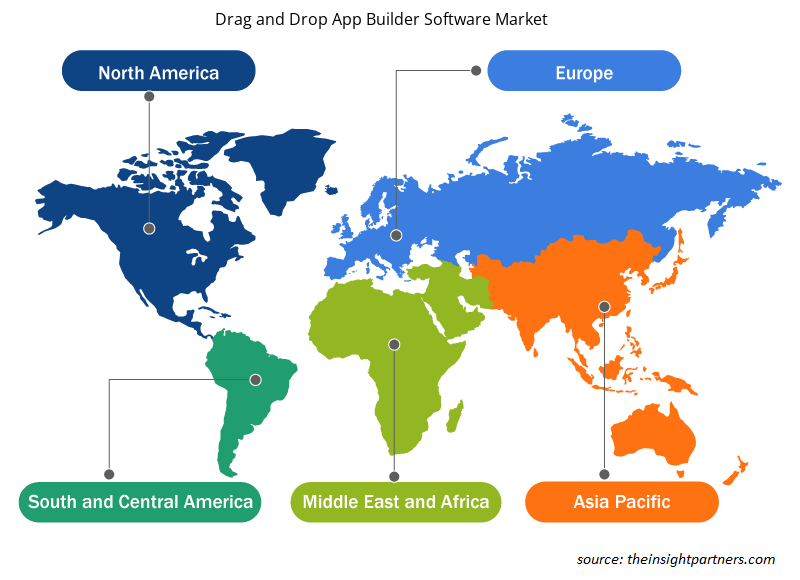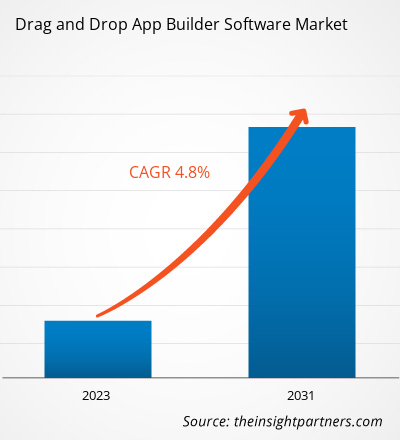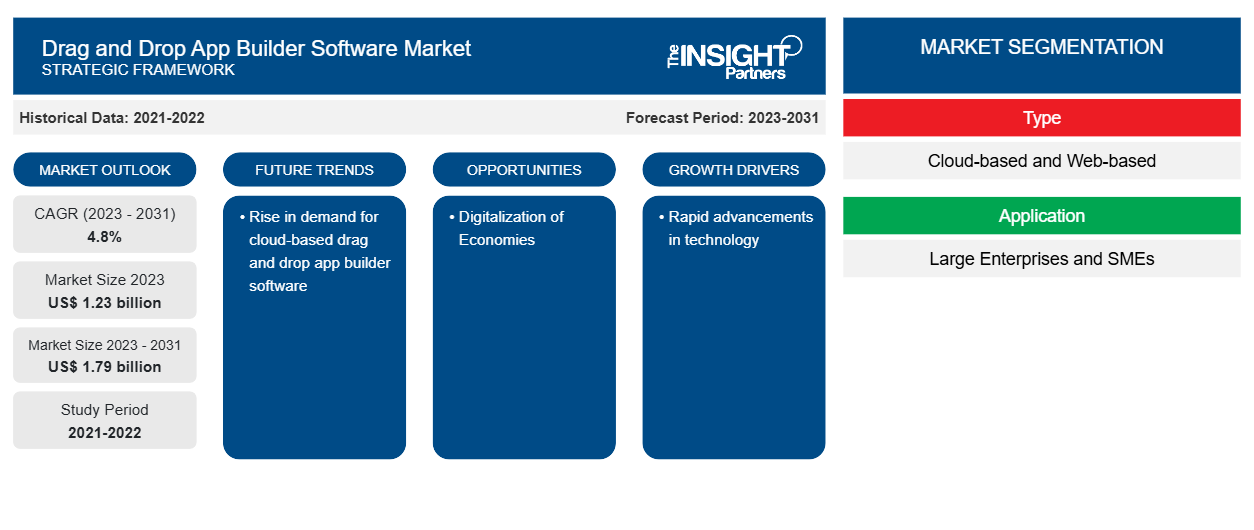La taille du marché des logiciels de création d'applications par glisser-déposer devrait passer de 1,23 milliard de dollars américains en 2023 à 1,79 milliard de dollars américains d'ici 2031 ; elle devrait croître à un TCAC de 4,8 % de 2023 à 2031. L'augmentation de la demande de logiciels de création d'applications par glisser-déposer basés sur le cloud devrait rester l'une des principales tendances du marché des logiciels de création d'applications par glisser-déposer.
Analyse du marché des logiciels de création d'applications par glisser-déposer
Les progrès rapides de la technologie, tels que le cloud computing et le développement d’applications mobiles, ont contribué à la croissance du marché des logiciels de création d’applications par glisser-déposer.
Aperçu du marché des logiciels de création d'applications par glisser-déposer
Le logiciel de création d'applications par glisser-déposer est un outil révolutionnaire qui permet aux entreprises de créer des applications mobiles personnalisées sans avoir recours à un codage complexe ou à une expertise technique. Grâce à ce logiciel intuitif, même les personnes ayant des connaissances techniques limitées peuvent concevoir et développer des applications riches en fonctionnalités qui répondent à leurs besoins commerciaux spécifiques. De plus, ce logiciel propose une large gamme de modèles et de modules prédéfinis qui peuvent être facilement personnalisés pour refléter l'image de marque et les exigences uniques d'une entreprise. Les entreprises peuvent ajouter leurs logos, couleurs et polices pour créer une application cohérente et professionnelle qui correspond à l'identité de leur marque.
Personnalisez ce rapport en fonction de vos besoins
Vous bénéficierez d'une personnalisation gratuite de n'importe quel rapport, y compris de certaines parties de ce rapport, d'une analyse au niveau des pays, d'un pack de données Excel, ainsi que de superbes offres et réductions pour les start-ups et les universités.
-
Obtenez les principales tendances clés du marché de ce rapport.Cet échantillon GRATUIT comprendra une analyse de données, allant des tendances du marché aux estimations et prévisions.
Moteurs et opportunités du marché des logiciels de création d'applications par glisser-déposer
Les progrès rapides de la technologie favorisent le marché
Les avancées technologiques, telles que le cloud computing et le développement d'applications mobiles, ont joué un rôle important dans la croissance du marché des logiciels de création d'applications par glisser-déposer. Ces avancées ont révolutionné le secteur du développement d'applications mobiles et ont ouvert de nouvelles possibilités aux entreprises et aux développeurs pour créer des expériences mobiles riches et immersives. En conclusion, les avancées rapides de la technologie, notamment le cloud computing et l'adoption de plateformes de développement low-code et no-code, ont contribué à la croissance du marché des logiciels de création d'applications par glisser-déposer. Ces avancées ont révolutionné le secteur du développement d'applications mobiles , le rendant plus accessible et plus efficace pour les entreprises et les développeurs pour créer des expériences mobiles innovantes et immersives.
La numérisation des économies of Economies
La numérisation des économies a entraîné une demande accrue d'outils de développement d'applications conviviaux, ce qui a contribué à la croissance du marché des logiciels de création d'applications par glisser-déposer. Ces plateformes permettent aux développeurs de créer des applications personnalisées sans exigences de codage importantes ou avec un codage manuel minimal, ce qui leur permet d'accélérer le développement de produits de haute qualité. Cela contraste avec le cycle de vie de développement logiciel (SDLC) conventionnel qui nécessite généralement plus de temps et d'efforts. Le rythme rapide de la transformation numérique a poussé les entreprises à répondre rapidement aux besoins des consommateurs, et les créateurs d'applications par glisser-déposer sont apparus comme une solution pour faciliter ce processus.digitalization of economies has led to an increased demand for user-friendly app development tools, which has contributed to the growth of the drag and drop app builder software market. These platforms allow developers to create customized apps without extensive coding requirements or with minimal hand-coding, enabling them to accelerate the development of high-quality products. This is in contrast to the conventional software development life cycle (SDLC) that typically involves more time and effort. The rapid pace of digital transformation has driven companies to meet consumer needs quickly, and drag and drop app builders have emerged as a solution to facilitate this process.
Analyse de segmentation du rapport sur le marché des logiciels de création d'applications par glisser-déposer
Les segments clés qui ont contribué à la dérivation de l’analyse du marché des logiciels de création d’applications par glisser-déposer sont le type et l’application.
- En fonction du type, le marché est divisé en deux segments : le segment basé sur le cloud et le segment basé sur le Web. Le segment basé sur le cloud détenait une part de marché plus importante en 2023.
- En termes d'application, le marché est divisé en grandes entreprises et PME. Le segment des grandes entreprises détenait une part de marché plus importante en 2023.
Analyse des parts de marché des logiciels de création d'applications par glisser-déposer par zone géographique
La portée géographique du rapport sur le marché des logiciels de création d'applications par glisser-déposer est principalement divisée en cinq régions : Amérique du Nord, Asie-Pacifique, Europe, Moyen-Orient et Afrique, et Amérique du Sud/Amérique du Sud et centrale. L'Amérique du Nord a dominé le marché des logiciels de création d'applications par glisser-déposer en 2023. Les États-Unis et le Canada ont massivement investi dans des activités de recherche et développement, ce qui a conduit au développement de technologies avancées et innovantes sur le marché des logiciels de création d'applications par glisser-déposer. En outre, les petites et moyennes entreprises (PME) opérant dans le secteur informatique en Amérique du Nord devraient stimuler le marché en raison de l'accessibilité croissante des solutions basées sur le cloud.
Aperçu régional du marché des logiciels de création d'applications par glisser-déposer
Les tendances et facteurs régionaux influençant le marché des logiciels de création d’applications par glisser-déposer tout au long de la période de prévision ont été expliqués en détail par les analystes d’Insight Partners. Cette section traite également des segments et de la géographie du marché des logiciels de création d’applications par glisser-déposer en Amérique du Nord, en Europe, en Asie-Pacifique, au Moyen-Orient et en Afrique, ainsi qu’en Amérique du Sud et en Amérique centrale.

- Obtenez les données régionales spécifiques au marché des logiciels de création d'applications par glisser-déposer
Portée du rapport sur le marché des logiciels de création d'applications par glisser-déposer
| Attribut de rapport | Détails |
|---|---|
| Taille du marché en 2023 | 1,23 milliard de dollars américains |
| Taille du marché d'ici 2031 | 1,79 milliard de dollars américains |
| Taux de croissance annuel composé mondial (2023-2031) | 4,8% |
| Données historiques | 2021-2022 |
| Période de prévision | 2023-2031 |
| Segments couverts |
Par type
|
| Régions et pays couverts |
Amérique du Nord
|
| Leaders du marché et profils d'entreprises clés |
|
Densité des acteurs du marché : comprendre son impact sur la dynamique des entreprises
Le marché des logiciels de création d'applications par glisser-déposer connaît une croissance rapide, tirée par la demande croissante des utilisateurs finaux en raison de facteurs tels que l'évolution des préférences des consommateurs, les avancées technologiques et une plus grande sensibilisation aux avantages du produit. À mesure que la demande augmente, les entreprises élargissent leurs offres, innovent pour répondre aux besoins des consommateurs et capitalisent sur les tendances émergentes, ce qui alimente davantage la croissance du marché.
La densité des acteurs du marché fait référence à la répartition des entreprises ou des sociétés opérant sur un marché ou un secteur particulier. Elle indique le nombre de concurrents (acteurs du marché) présents sur un marché donné par rapport à sa taille ou à sa valeur marchande totale.
Les principales entreprises opérant sur le marché des logiciels de création d'applications par glisser-déposer sont :
- DroneHQ
- Salesforce
- Thunkable Inc.
- WaveMaker Inc.
- Société Zoho
- Mobirise
Avis de non-responsabilité : les sociétés répertoriées ci-dessus ne sont pas classées dans un ordre particulier.

- Obtenez un aperçu des principaux acteurs du marché des logiciels de création d'applications par glisser-déposer
Actualités et développements récents du marché des logiciels de création d'applications par glisser-déposer
Le marché des logiciels de création d'applications par glisser-déposer est évalué en collectant des données qualitatives et quantitatives après des recherches primaires et secondaires, qui comprennent des publications d'entreprise importantes, des données d'association et des bases de données. Voici une liste des évolutions du marché :
- En décembre 2020, Quixy, une importante plateforme de développement d'applications sans code et de gestion des processus métier (BPM), a obtenu la distinction distinguée d'être nommée « Leader » dans la catégorie Développement d'applications sans code par G2, une autorité renommée du secteur.
(Source : Quixy, Communiqué de presse, 2020)
- En septembre 2020, DronaHQ a organisé un hackathon sans code dans le but d'engager les étudiants en école de commerce et de favoriser les traits de développement citoyen et un état d'esprit de résolution de problèmes. Le hackathon a donné l'occasion aux étudiants d'apprendre le développement d'applications sans avoir besoin de connaissances approfondies en codage.
(Source : DronaHQ, Communiqué de presse, 2020)
Rapport sur le marché des logiciels de création d'applications par glisser-déposer et livrables
Le rapport « Taille et prévisions du marché des logiciels de création d'applications par glisser-déposer (2021-2031) » fournit une analyse détaillée du marché couvrant les domaines ci-dessous :
- Taille du marché et prévisions aux niveaux mondial, régional et national pour tous les segments de marché clés couverts par le périmètre
- Dynamique du marché, comme les facteurs moteurs, les contraintes et les opportunités clés
- Principales tendances futures
- Analyse détaillée des cinq forces de PEST/Porter et SWOT
- Analyse du marché mondial et régional couvrant les principales tendances du marché, les principaux acteurs, les réglementations et les développements récents du marché
- Analyse du paysage industriel et de la concurrence couvrant la concentration du marché, l'analyse de la carte thermique, les principaux acteurs et les développements récents
- Profils d'entreprise détaillés
- Analyse historique (2 ans), année de base, prévision (7 ans) avec TCAC
- Analyse PEST et SWOT
- Taille du marché Valeur / Volume - Mondial, Régional, Pays
- Industrie et paysage concurrentiel
- Ensemble de données Excel
Rapports récents
Rapports connexes
Témoignages
Raison d'acheter
- Prise de décision éclairée
- Compréhension de la dynamique du marché
- Analyse concurrentielle
- Connaissances clients
- Prévisions de marché
- Atténuation des risques
- Planification stratégique
- Justification des investissements
- Identification des marchés émergents
- Amélioration des stratégies marketing
- Amélioration de l'efficacité opérationnelle
- Alignement sur les tendances réglementaires























 Obtenez un échantillon gratuit pour - Marché des logiciels de création d'applications par glisser-déposer
Obtenez un échantillon gratuit pour - Marché des logiciels de création d'applications par glisser-déposer